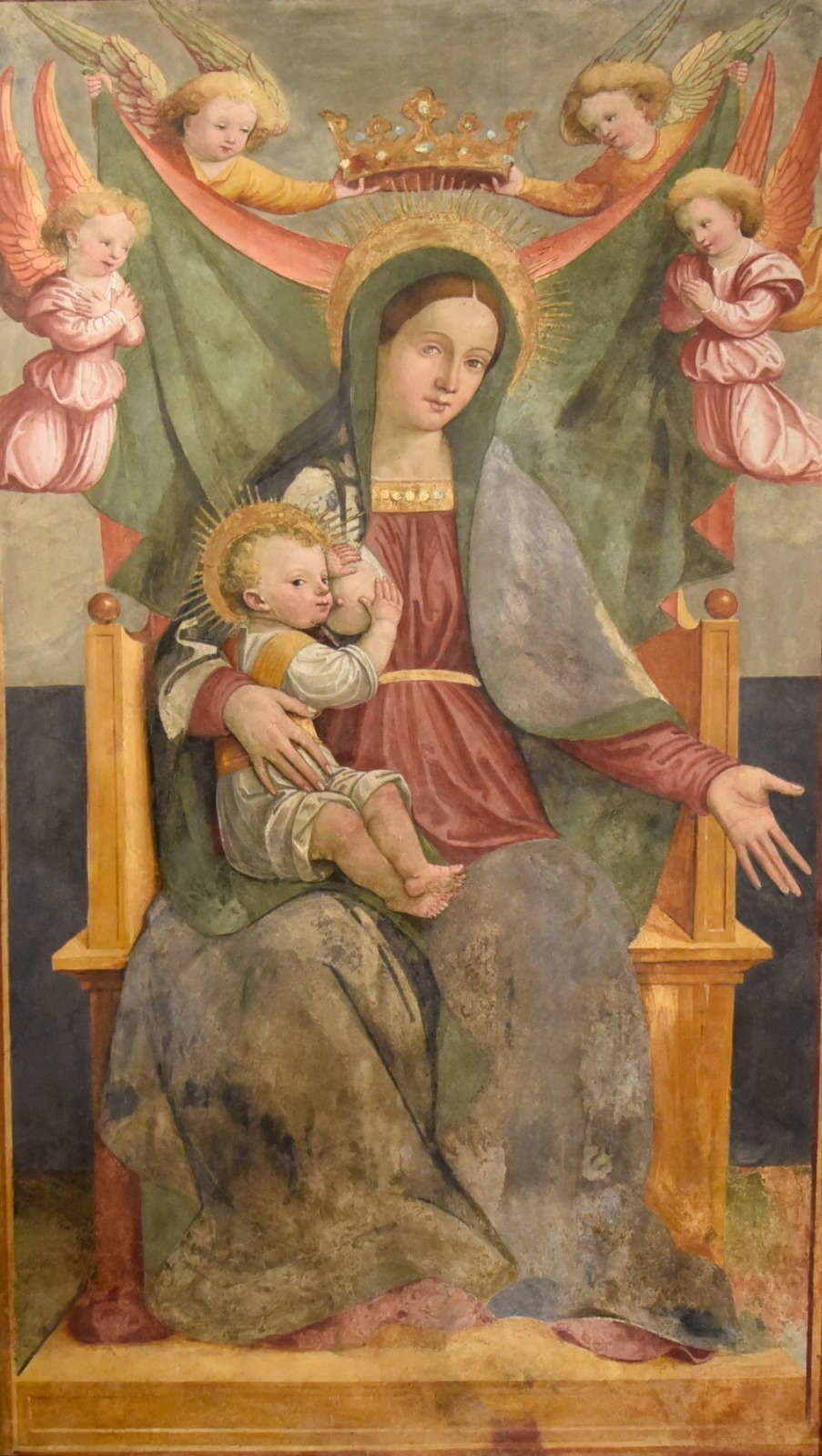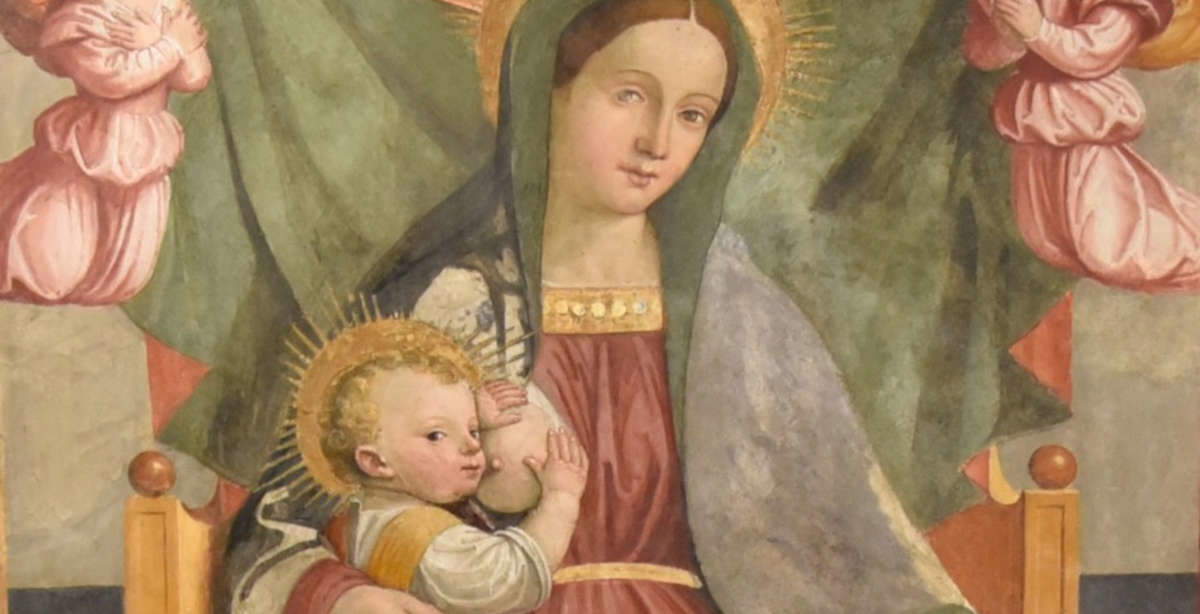Brescia, finishes restoration of Andrea Marone's Madonna of the Milk
Important restoration in Brescia, where work has been completed on the Madonna Enthroned Suckling the Child by Andrea Marone da Manerbio, a member of a family of artists with deep roots in Renaissance Brescia. The restoration of the fresco, executed around 1525, was presented by Fondazione Brescia Musei and the Municipality of Brescia and was made possible thanks to the contribution of the company Ingegneri Progettisti e Affini, using the Art bonus tool, which offers tax benefits to those who make donations for culture. Fondazione Brescia Musei has integrated this opportunity into its initiatives to actively involve the public in the life and projects of the Museums. Now the restored work is on long display in the Museum’s itinerary, following a special unveiling during Mother’s Day, which was held yesterday, May 12.
The fresco comes from the exterior of the small church of Saints Hippolytus and Cassian, demolished in 1904, where it was placed within a small masonry altar, but the known history of the work, also known as the "Madonna del Latte," has its roots in the 17th century, when the Brescian painter and art writer Francesco Paglia first mentioned it. The subject depicted is one of the most frequent in the Christian tradition: the Virgin, seated on a throne, shows a welcoming gesture with her left hand, while holding the Child, who, holding his mother’s breast, turns directly to the viewer.
Only recently has the painting’s author been identified, Andrea Marone da Manerbio, part of a family of artists probably originally from Sebino but rooted in Brescia. According to Fiorella Frisoni, the painter, active between Brescia, Bassa Bresciana and Lake Iseo, showed a different orientation than the great artists of the period, such as Moretto, Romanino and Savoldo, taking his cue from cities such as Cremona, Lodi and Milan, but also from the areas of the Lombard lakes as far as Canton Ticino. His models included artists such as Boccaccio Boccaccino and Galeazzo Campi of Cremona, the Lodi painters, to Bernardino Luini of the Milanese frescoes of San Maurizio at the Monastero Maggiore.
These stylistic orientations are reflected in the Brescian frescoes as well, as evidenced by the elegance of the faces, the delicate dotted highlights, the redundant and falcate draperies, and the balanced colors. While the overall layout shows an archaic arrangement, with the angels in the upper register recalling the quasi-medieval style, it is the details that make the difference in terms of quality, such as the Child’s stringy curls, the enameled highlights of the nails, and the golden inserts of the Virgin’s haloes and crown.
The fresco, which enjoyed deep popular devotion, was detached in 1878 by Brescian restorer Giuliano Volpi, commissioned by the municipality. This intervention involved removing not only the painted plaster, but also a significant portion of the masonry behind it, using a special extraction technique called stacco a massello.

The restoration
The restoration of Andrea Marone’s fresco was a rare occasion in the field of mural painting conservation, as interventions on stacco a massello are quite unusual. This complex and expensive extractive technique is generally reserved for artifacts of great artistic importance and value. Historically, the reasons for detaching a painting are mainly related to the situation of the building that houses it: structural instability, the need for demolition, or, especially in the past, problems related to humidity.
The work by Andrea Marone, which has come down to us in a complex condition, showed severe damage caused by the presence of salts that caused cratering and pulverization of the painting’s surface, with significant loss of pictorial matter, especially in the lower areas. The painting, of remarkable artistic quality and skillfully executed, was executed on a thin layer of smooth and compact plaster made of lime and very fine aggregates. The good fresco drafts were complemented by valuable dry work, using protein binders, including traces of malachite and azurite for the Madonna’s mantle and the veil supported by the angels. Gilding, combined with decorations in lean tempera and lacquer, embellished the Madonna’s crown, the collar of the dress, the girdle, and the haloes.
Cleaning involved the removal of a dull gray layer consisting mainly of deposits of atmospheric particulates and smoke black, as well as heavily degraded animal glues and adhesives applied in previous interventions. Unfortunately, due to the complex lived history of the fresco, the detachment operations and the subsequent interventions, there was an almost total loss of the valuable dry pictorial finishes.
The surfaces were carefully examined using polarized light microscopy, with additional local checks under UV imaging, to refine knowledge of the execution techniques and accurately assess the quality and extent of the repainting and retouching interventions. The previous aesthetic repainting interventions were significantly altered, with numerous pigments subject to chromatic discoloration due to binder degradation.
During the detachment and subsequent interventions, a large amount of glues of animal origin was used, which partially infiltrated the inner layers of the fresco. Consequently, it was necessary to conduct a preliminary study of the surfaces from a microbiological point of view in order to plan appropriate biological treatment and subsequent conservation steps. Numerous swab surveys were carried out at different stages and analyzed by instrumental bioluminescence from luciferase.
After cleaning, the fresco was carefully consolidated to ensure the cohesion of the color and its future preservation. Some plastering was carried out to repair the gaps present, followed by a lengthy intervention of punctual retouching in watercolor. This allowed the recovery of the overall legibility of the work, while maintaining evident signs of its complex past.
Statements
“The work,” says Roberta D’Adda, Coordinator Sector Collections and Research Fondazione Brescia Musei, “came to us in a conservatively complex condition. The intervention presented a technical peculiarity related to the fact that it is a massello detachment, that is, a real portion of the wall, a fact not so frequent in the field of conservation of wall paintings. The essential support of restorer Massimiliano Lombardi gives us back a precious treasure.”
“I was pleased to choose to support the restoration of the work, which immediately struck me as a beautiful object,” says Marco Medeghini, CEO of Ingegneri Progettisti e Affini. “Directing part, albeit small, of the fruit of one’s labor in a direct way toward Brescia Musei instead of dispersing it in the cauldron of general taxation feels useful, necessary and beautiful. For me and for my city. Because opening oneself to giving is still a mature experience of participation in social work that holds many joys. It is written ’he who gives is happier than he who receives.’ I wish everyone this experience.”
“With the restoration of this important fresco,” stresses Stefano Karadjov, director of Fondazione Brescia Musei, “we enrich the exhibition itinerary of the Santa Giulia Museum by placing the new work in dialogue with the crucifixion of the mourners St. Catherine and St. Jerome in the chapel of the Madonna of the basilica of San Salvatore and with the death of St. Obizio, also in San Salvatore. An exhibition itinerary, that of Santa Giulia, enlivened by the continuous research and enhancement activities of the conservation and promotion team of our splendid museum.”
“Today we celebrate a new example of generosity to society at large, from a citizen who demonstrates that he fully understands the role of community members in protecting and restoring the founding heritage of his own ’heritage community,’” highlights Francesca Bazoli, President of Fondazione Brescia Musei. “And we also remember how important it is to recount the tools provided by our regulations, which make it possible to contribute to the work of the Foundation in the direction of the redevelopment of the Museums and the works of art of the civic Collections, while also obtaining a not insignificant tax benefit. Fondazione Brescia Musei’s gratitude, therefore, to engineer Marco Medeghini and the company Ingegneri Progettisti e Affini, as well as to restorer Massimiliano Lombardi, who allowed us to recover in an extraordinary way this small masterpiece belonging to the history of the Brescian community.”
“Thanks to the generous contribution of a firm of Brescian professionals, after 120 years our city will be able to rediscover a 16th-century masterpiece that has been an object of lively and profound devotion for centuries,” says Roberto Rossini, president of the Brescia City Council. “Not only has the splendid fresco of the Madonna Enthroned Suckling the Child crowned by four angels by Andrea Marone da Manerbio been fully restored, thanks to the Art bonus, but it will remain on display in the Santa Giulia Museum for a long time, finding its rightful place. Therefore, I can only applaud this noble project that will allow the artistic and cultural heritage of Brescia to be enriched and, for many citizens and tourists, to appreciate a work of great value.”
 |
| Brescia, finishes restoration of Andrea Marone's Madonna of the Milk |
Warning: the translation into English of the original Italian article was created using automatic tools. We undertake to review all articles, but we do not guarantee the total absence of inaccuracies in the translation due to the program. You can find the original by clicking on the ITA button. If you find any mistake,please contact us.



























